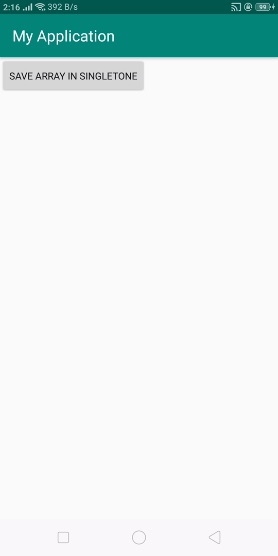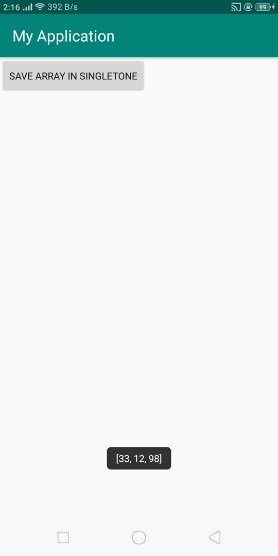
 Data Structure
Data Structure Networking
Networking RDBMS
RDBMS Operating System
Operating System Java
Java MS Excel
MS Excel iOS
iOS HTML
HTML CSS
CSS Android
Android Python
Python C Programming
C Programming C++
C++ C#
C# MongoDB
MongoDB MySQL
MySQL Javascript
Javascript PHP
PHP
- Selected Reading
- UPSC IAS Exams Notes
- Developer's Best Practices
- Questions and Answers
- Effective Resume Writing
- HR Interview Questions
- Computer Glossary
- Who is Who
How to store array Singleton with Global Context in android?
Before getting into example, we should know what singleton design pattern is. A singleton is a design pattern that restricts the instantiation of a class to only one instance. Notable uses include controlling concurrency and creating a central point of access for an application to access its data store.
This example demonstrate about How to store array Singleton with Global Context in android
Step 1 − Create a new project in Android Studio, go to File ⇒ New Project and fill all required details to create a new project.
Step 2 − Add the following code to res/layout/activity_main.xml.
<?xml version = "1.0" encoding = "utf-8"?> <LinearLayout xmlns:android = "http://schemas.android.com/apk/res/android" xmlns:tools = "http://schemas.android.com/tools" android:layout_width = "match_parent" android:layout_height = "match_parent" tools:context = ".MainActivity" android:orientation = "vertical"> <Button android:id = "@+id/show" android:text = "save array in singleTone" android:layout_width = "wrap_content" android:layout_height = "wrap_content" /> </LinearLayout>
In the above code, we have taken a button. When user click on show button, it will show array values in toast.
Step 3 − Add the following code to src/MainActivity.java
package com.example.andy.myapplication;
import android.os.Bundle;
import android.support.v7.app.AppCompatActivity;
import android.view.View;
import android.widget.Button;
import android.widget.Toast;
public class MainActivity extends AppCompatActivity {
Button show;
int[] i1 = new int[] { 33, 12, 98 };
singleTonExample singletonexample;
@Override
protected void onCreate(Bundle savedInstanceState) {
super.onCreate(savedInstanceState);
setContentView(R.layout.activity_main);
show = findViewById(R.id.show);
singletonexample = singleTonExample.getInstance();
singletonexample.init(getApplicationContext());
show.setOnClickListener(new View.OnClickListener() {
@Override
public void onClick(View v) {
singletonexample.storeArray(i1);
Toast.makeText(singleTonExample.get(),singletonexample.getArray(),
Toast.LENGTH_LONG).show();
}
});
}
}
In the above code, we have used singleTonExample as singleton class so create a call as singleTonExample.java and add the following code-
package com.example.andy.myapplication;
import android.app.Dialog;
import android.content.Context;
import android.view.Window;
import java.util.Arrays;
public class singleTonExample {
private Context appContext;
private Dialog dialog;
int[] i1;
private static final singleTonExample ourInstance = new singleTonExample();
public void init(Context context) {
if(appContext == null) {
this.appContext = context;
}
}
private Context getContext() {
return appContext;
}
public static Context get() {
return getInstance().getContext();
}
public static synchronized singleTonExample getInstance() {
return ourInstance;
}
private singleTonExample() { }
public void show(Context context) {
if (dialog != null && dialog.isShowing()) {
return;
}
dialog = new Dialog(context);
dialog.requestWindowFeature(Window.FEATURE_NO_TITLE);
dialog.setContentView(R.layout.layout_progress_dialog);
dialog.setCancelable(true);
dialog.show();
}
public void dismiss() {
if (dialog != null && dialog.isShowing()) {
dialog.dismiss();
}
}
public void storeArray(int[] i1) {
this.i1 = i1;
}
public String getArray() {
return Arrays.toString(i1);
}
}
Let's try to run your application. I assume you have connected your actual Android Mobile device with your computer. To run the app from android studio, open one of your project's activity files and click Run ![]() icon from the toolbar. Select your mobile device as an option and then check your mobile device which will display your default screen –
icon from the toolbar. Select your mobile device as an option and then check your mobile device which will display your default screen –

Now click on above button, it will show array values in toast using global context as shown below –

Click here to download the project code

